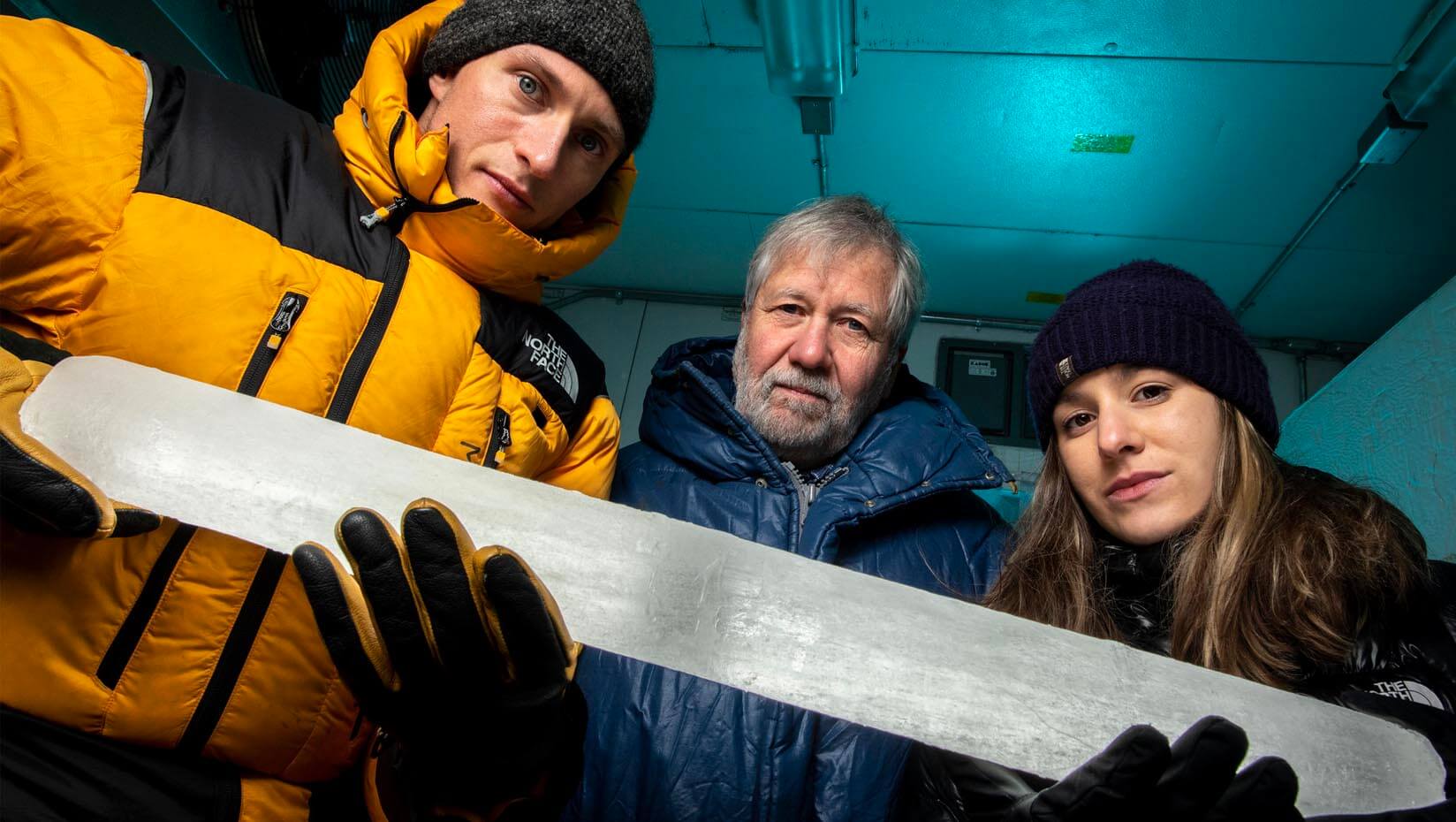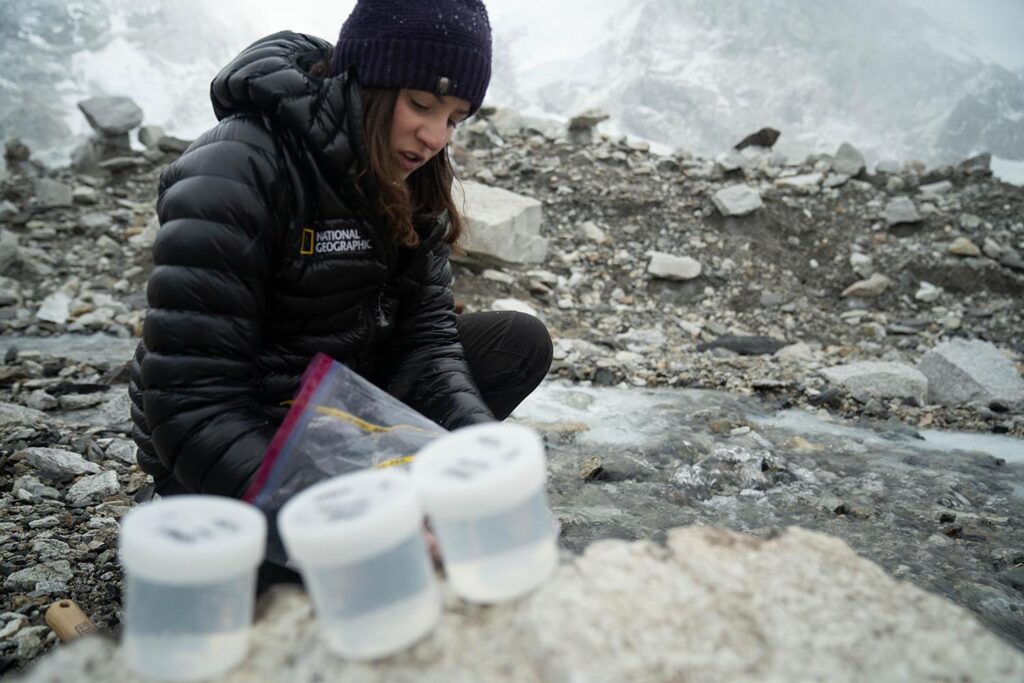
Clifford: Tourism, wind-transported metal pollution threaten drinking water around Everest
Increased local tourism and toxic substances transported to glaciers from distant locales can contribute to high concentrations of human-sourced metal pollution in snow and streams around Mount Everest that is likely degrading the quality of water used by thousands of residents and climbers.
Heather Clifford made the discoveries in a study she conducted after taking part in the 2019 National Geographic and Rolex Perpetual Planet Everest Expedition.
Clifford, a doctoral student in the Climate Change Institute at the University of Maine, is part of the international team seeking to better understand the effects of climate change on glaciers of the Hindu Kush-Himalaya that provide critical water resources to 1 billion people downstream.
“While our results are preliminary, we find there could be concern regarding the health of those who depend on the Khumbu Glacier melt for drinking water and irrigation,” she says.
“Further spatial environmental monitoring, specifically looking into the chemical and biological makeup of the streams, could help to assess health impacts, water quality and potential sources of heavy metals.”
While heavy metals occur naturally in the environment, human activity results in significantly higher levels in the atmosphere, which can negatively impact human and ecosystem health.

Heavy metals can increase the chances of having a miscarriage, a stillbirth, or a child with a birth defect, as well as affect a baby’s brain development, according to the Centers for Disease Control and Prevention. They also can affect people’s central nervous function, leading to mental disorders, and they may damage the lungs, liver, kidneys and other vital organs.
Precipitation and melt can contain toxic substances from local activities as well as distant sources. As snow and glaciers melt, entrapped chemicals are released.
Some local pollution sources for the Khumbu region include aviation fuel for helicopters, generators, batteries and incinerators. Clifford, a member of the expedition’s glaciology team, said human waste at Everest Base Camp also could be contributing to degraded water quality.
Distant pollution sources include mining, metal smelting, oil, and coal combustion. Long-range transport and deposition of aerosols in the Himalayas are strongly influenced by the seasonal migration of the South Asian monsoon that, along with westerly winds, transport these chemicals.
Clifford’s research, “A case study using 2019 pre-monsoon snow and stream chemistry in the Khumbu region, Nepal” is online in Science of the Total Environment, an international multi-disciplinary journal for novel, hypothesis-driven and high-impact research.
In 2019, she analyzed the chemical composition of pre-monsoon samples of stream water at 4,300–5,250 meters and snow at 5,200–6,665 meters from Mount Everest, Mount Lobuche, and the Imja Valley, in addition to a shallow ice core recovered from the Khumbu Glacier at 5,300 meters.
Clifford believes this is the first such analysis on Khumbu Glacier ice and the first detailed characterization of pre-monsoon snow/water elemental chemistry for the region.
Increased environmental monitoring is needed, says Clifford, as climate change and tourism will increase vulnerability in the area.
Meltwater from the Khumbu Glacier and others provides about 65% of the local water supply during the dry, pre-monsoon season. The 3,500–6,000 local people there depend on stream water, including for drinking and irrigation.
And, about 57,000 trekkers, climbers, and local support teams annually trek to Everest Base Camp; several thousand climbers seasonally live there and depend on local streams derived from Khumbu Glacier melt for drinking and cooking.
Measuring lead, bismuth, and other trace elements in the atmosphere and snow could help fingerprint the sources of the human pollutants, says Clifford, who earned her master’s degree at UMaine. She celebrated her Commencement at Mount Everest’s Base Camp — at 17,514 feet.
Clifford’s research provides an essential framework for future research in not only the Everest region but in all mountain system regions, says Paul Mayewski, CCI director and the Scientific and Expedition Lead of the 2019 National Geographic and Rolex Perpetual Planet Everest Expedition.
In addition to Mayewski, UMaine colleagues on the research team are Mariusz Potocki, a member of the climbing and glaciology teams; Mike Handley; Elena Korotkikh; Douglas Introne; and Kimberley Miner.
Additional co-authors are Inka Koch of the International Centre for Integrated Mountain Development in Nepal and the University of Tübingenin in Germany, Tenzing Sherpa of the International Centre for Integrated Mountain Development, Susan Kaspari of Central Washington University, Tom Matthews of Loughborough University in the United Kingdom, Baker Perry of Appalachian State University in North Carolina, Heather Guy of the University of Leeds in the United Kingdom, Ananta Gajurel of Tribhuvan University in Nepal, Praveen Kumar Singh of the International Centre for Integrated Mountain Development and the Indian Institute of Technology Roorkee in India, and Aurora C. Elmore and Alex Tait of the National Geographic Society in Washington, D.C.
Contact: Beth Staples, beth.staples@maine.edu
